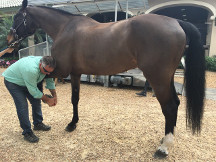
- VOL 18. ISSUE 5
March 02, 2018
SEARCH NEWS & VIEWS

Cross-bred flies reveal new clues about how proteins are regulated
'Click chemistry' reactions may boost cancer-fighting drug potency
Decoding the genome’s dark matter
TSRI scientists receive $15 million to study viral outbreak survivors
Next-generation arthritis treatments could benefit both horses and humans
NEWS & VIEWS HOME
PAST ISSUES
KUDOS
SCIENTIFIC CALENDAR
CA AUDITORIUM EVENTS
CONTACT

- The San Diego Union-Tribune
Scripps Research stroke drug shows effectiveness, safety - GenomeWeb
Researchers Build Map of Sequence Constraints for Human Genome



FOLLOW US



Next-generation arthritis treatments could benefit both horses and humans
By Stacey Singer DeLoye
At the Palm Beach International Equestrian Center, members of the riding and jumping community recently heard about studies underway at The Scripps Research Institute (TSRI) and Colorado State University intended to improve their health and that of their elite horses. TSRI Professor Paul Robbins, PhD, who develops therapies to address cellular senescence and aging-related diseases, has collaborated with David Frisbie, DVM, PhD, and Wayne McIlwraith, DVM, PhD, at Colorado State University’s Orthopedic Research Center to advance innovative osteoarthritis treatments for horses and humans.
More than 27 million people live with osteoarthritis, and it turns out, elite racing and jumping horses do, too. Repeated athletic performance can damage cartilage, said Timothy Ober, DVM, senior veterinarian with John R. Steele & Associates and U.S. Team Veterinarian, Show Jumping. Cartilage lacks a blood and nerve supply, and so it generally doesn’t heal well on its own. Robbins told the group of about 40 equestrians and veterinarians who attended the Feb. 6 symposium about KA34, a compound discovered at the TSRI-affiliated non-profit the California Institute for Biomedical Research (Calibr). The experimental drug encourages adult stem cells in the joint to mature toward chondrocytes, the cells that produce and maintain healthy cartilage, Robbins said. Robbins said clearing senescent cells, which may drive inflammation and many other diseases of aging, including arthritis, may one day be a complementary therapy to such regenerative approaches.
“We have identified two drugs that actually reduce the level of senescent cells. In animals, speed, endurance and strength improves after treatment,” Robbins told the equestrians.
Intervening to prevent early cartilage loss in horses is an important goal, Ober added. “Joint pain and joint inflammation are the biggest challenge we face,” Ober said.
Send comments to: press[at]scripps.edu


Timothy Ober, DVM, with a horse at the recent event. (Photo by Stacey Singer DeLoye)




